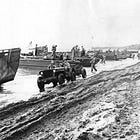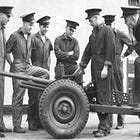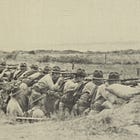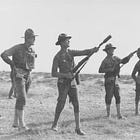Growth of the Marine Infantry Regiment (March 1941-April 1943)
Battalion: An Organizational Study of United States Infantry
Adopted on 28 March 1941, the D-series tables of organization remained in force for a little more than two years. During that time the Marine Corps made two sets of changes to them. The first of these bore the date of 10 January 1942. The second received official blessing on 1 July 1942.
Thanks to these changes, the authorized strength of the Marine infantry regiment increased from 2,996 to 3,168. In other words, the ideal Marine infantry regiment of 1 July 1942 was some five percent larger than than its full-strength counterpart of 28 March 1941.

Most of the growth within the regiment (135 of the 172 officers and men added during this period) took place within the three infantry battalions. Of the rest, nearly all of the increase (36 out of 37) occurred within the regimental headquarters and service company, and, in particular, the regimental communications platoon.

Within each infantry battalion, the number of Marines in each rifle company grew slightly, the number of Marines in the weapons company grew somewhat, and the number of Marines in the headquarters company grew considerably. (The headquarters company of each infantry battalion also provided a home for two medical officers and twenty hospital corpsmen of the US Navy. This number, however, did not change during the two year reign of the D-series tables of organization.)
Of the twenty Marines added to the headquarters company of each infantry battalion, sixteen served in the communications platoon. Of these, one strung wire, three drove jeeps, and twelve turned the dials on radio sets.

For More about the Marine Infantry Regiment of 28 March 1941:
To Share, Subscribe, or Support The Tactical Notebook:












I believe that Napoleon said: “God favors the larger Battalions.” Combat has a way of introducing reality. Smaller Battalions depend on the support promises of others that rarely are provided in the right place at the right time. I don’t like sports analogies but some are germane. The owner of a football franchise would love to have one coach and no more than 15 players. That looks good on the practice field and the budget. Maybe, reluctantly 22 players. But, that team can’t win a game or prevail over an entire season.
Who carries the wounded to the rear, who escorts enemy POWs, who carries the ammunition….? What size Bn has the ability to counter attack?
I lived this for 27 years of active duty as an infantry officer through Regimental Commander. In my opinion the optimal squad size is 15, the platoon is 49, the company 211. Each Bn needs four maneuver companies, a Weapons Company and an H&S company with a total of 1256 Marines. A Regiment would be 4986 Marines.
If you want good comms the signal Corps must grow in both operators and maintenance.
Not to mention emissions control and counter measures just become a problem down to the squad and team level.
This was true then and more true now. It’s nice to talk about Operator maintenance. It’s not nice cleaning behind it.
It’s nice to talk about increasing tooth by reducing tail. What actually happened was the system killed maintenance to make way for larger staffs and HR jobs by whatever name.
Had they known what they were doing, they’d have realized the up or out system- the great evil of McNamara raising its eternal Hydra head- up or out drives the creation of large staffs and HR, educational structures to keep the talent you’ve invested years in, or to render their career prospects and even retirement hopeless and toss a large number of embittered 30 somethings into unemployment. *
* like the USMC does .